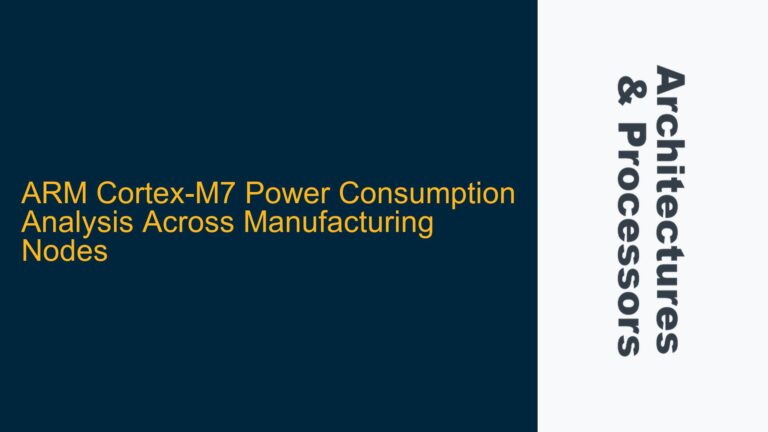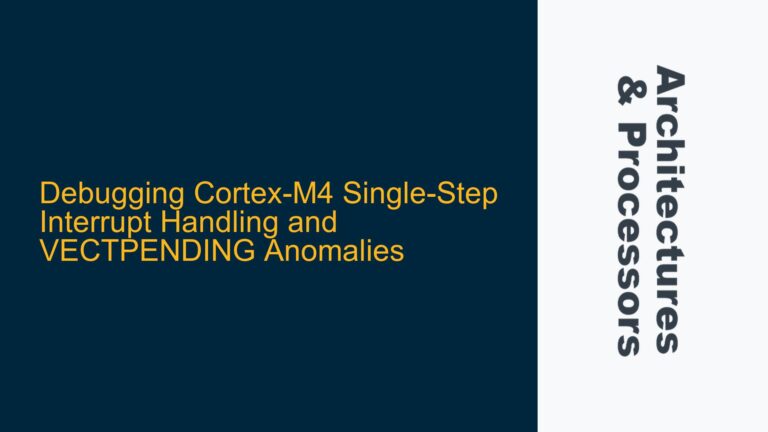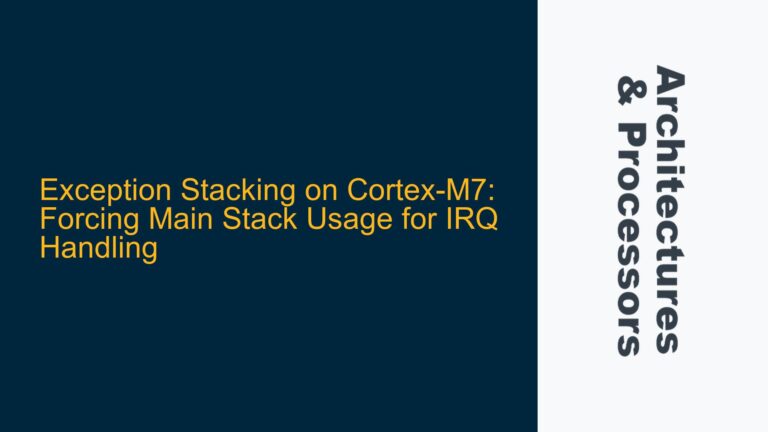ARM Cortex-M Migration Challenges from LPC2378 to Modern Alternatives
The LPC2378, based on the ARM7TDMI-S core, has been a reliable workhorse for embedded systems for many years. However, with its obsolescence, developers are now faced with the challenge of migrating to a modern ARM Cortex-M-based microcontroller that offers long-term availability, improved performance, and enhanced features. The LPC2378’s architecture, while robust for its time, lacks many of the advancements found in modern Cortex-M processors, such as higher clock speeds, integrated peripherals, and advanced power management. Migrating from the LPC2378 to a Cortex-M device requires careful consideration of several factors, including peripheral compatibility, memory architecture, and software migration.
The ARM7TDMI-S core in the LPC2378 operates at a maximum frequency of 72 MHz and features a 3-stage pipeline, Thumb instruction set support, and a von Neumann architecture with a single bus interface for both instruction and data. In contrast, modern Cortex-M processors, such as the Cortex-M3, Cortex-M4, and Cortex-M7, offer significantly higher performance, with clock speeds exceeding 200 MHz, Harvard architecture with separate instruction and data buses, and advanced features like DSP instructions, floating-point units, and memory protection units. These differences necessitate a thorough understanding of both architectures to ensure a smooth transition.
One of the primary challenges in migrating from the LPC2378 to a Cortex-M device is the difference in memory architecture. The LPC2378 uses a von Neumann architecture, where instructions and data share the same memory space and bus. This can lead to bottlenecks when fetching instructions and accessing data simultaneously. Cortex-M processors, on the other hand, employ a Harvard architecture with separate buses for instructions and data, allowing for concurrent access and improved performance. However, this architectural difference can complicate the migration process, particularly when dealing with legacy code that assumes a unified memory space.
Another significant consideration is peripheral compatibility. The LPC2378 features a set of peripherals that may not have direct equivalents in modern Cortex-M devices. For example, the LPC2378 includes a 10-bit ADC, multiple UARTs, and a CAN controller. While most Cortex-M devices offer similar peripherals, the specific implementations and register interfaces may differ, requiring modifications to the driver code. Additionally, modern Cortex-M devices often include newer peripherals, such as USB controllers, Ethernet MACs, and advanced timers, which can provide enhanced functionality but may also require additional software development.
Power management is another area where the LPC2378 and Cortex-M devices differ significantly. The LPC2378 offers basic power-saving modes, such as idle and power-down, but lacks the sophisticated power management features found in Cortex-M processors. Modern Cortex-M devices provide multiple low-power modes, dynamic voltage and frequency scaling, and advanced clock gating techniques, enabling developers to optimize power consumption for battery-operated applications. However, leveraging these features requires a deep understanding of the power management architecture and may involve significant changes to the existing software.
Peripheral Compatibility and Memory Architecture Differences
When migrating from the LPC2378 to a modern Cortex-M device, one of the most critical aspects to consider is the compatibility of peripherals and the differences in memory architecture. The LPC2378’s peripherals, while functional, are based on older technology and may not have direct equivalents in newer Cortex-M devices. This can lead to challenges in porting existing code and ensuring that the new device meets the project’s requirements.
The LPC2378 features a 10-bit ADC, which is commonly used for analog signal acquisition. While most Cortex-M devices also include ADCs, the resolution and performance characteristics may vary. For instance, some Cortex-M devices offer 12-bit ADCs with higher sampling rates and lower noise levels, which can improve the accuracy of analog measurements. However, the increased resolution and performance may require adjustments to the existing code, such as recalibrating the ADC or modifying the data processing algorithms.
UARTs are another peripheral that requires careful consideration during migration. The LPC2378 includes multiple UARTs, which are often used for communication with external devices or debugging. Cortex-M devices typically offer UARTs with similar functionality, but the register interfaces and configuration options may differ. For example, some Cortex-M UARTs support advanced features like hardware flow control, FIFO buffers, and DMA integration, which can enhance performance but may also require changes to the existing UART driver code.
The CAN controller in the LPC2378 is another peripheral that may not have a direct equivalent in some Cortex-M devices. CAN is commonly used in automotive and industrial applications for reliable communication between nodes. While many Cortex-M devices include CAN controllers, the specific implementation and register interfaces may vary, necessitating modifications to the CAN driver code. Additionally, some Cortex-M devices offer CAN FD (Flexible Data Rate) support, which provides higher data rates and larger payloads compared to traditional CAN. However, leveraging CAN FD requires updates to the communication protocol and software stack.
Memory architecture differences between the LPC2378 and Cortex-M devices also pose significant challenges. The LPC2378’s von Neumann architecture, with its single bus for instructions and data, can lead to performance bottlenecks when accessing memory. Cortex-M processors, with their Harvard architecture and separate instruction and data buses, offer improved performance but require careful consideration of memory allocation and access patterns. For example, the LPC2378’s unified memory space allows for flexible memory usage, but this flexibility can lead to inefficiencies in a Harvard architecture. Developers may need to reorganize memory segments and optimize data access patterns to fully leverage the performance benefits of the Cortex-M architecture.
Implementing Power Management and Optimizing Software for Cortex-M
Power management is a critical aspect of modern embedded systems, particularly for battery-operated applications. The LPC2378 offers basic power-saving modes, such as idle and power-down, but lacks the advanced power management features found in Cortex-M devices. Migrating to a Cortex-M device provides an opportunity to optimize power consumption, but it also requires a deep understanding of the new power management architecture and may involve significant changes to the existing software.
Cortex-M devices offer multiple low-power modes, each with different levels of power consumption and wake-up times. For example, sleep mode reduces power consumption by disabling the CPU clock while keeping peripherals active, allowing for quick wake-up in response to external events. Deep sleep mode further reduces power consumption by disabling additional peripherals and reducing the clock frequency, but requires more time to wake up. Understanding the trade-offs between power consumption and wake-up time is essential for selecting the appropriate low-power mode for a given application.
Dynamic voltage and frequency scaling (DVFS) is another power management feature available in many Cortex-M devices. DVFS allows the CPU frequency and voltage to be adjusted dynamically based on the workload, reducing power consumption during periods of low activity. Implementing DVFS requires careful consideration of the application’s performance requirements and power constraints, as well as modifications to the software to adjust the CPU frequency and voltage at runtime.
Clock gating is a technique used in Cortex-M devices to reduce power consumption by disabling the clock signal to unused peripherals and modules. This can significantly reduce power consumption, particularly in applications with long periods of inactivity. However, implementing clock gating requires a thorough understanding of the device’s clock tree and peripheral dependencies, as well as modifications to the software to enable and disable clock gating as needed.
Optimizing software for Cortex-M devices also involves leveraging the advanced features and performance improvements offered by the new architecture. For example, Cortex-M devices often include hardware acceleration for common tasks, such as DSP operations and floating-point calculations. Utilizing these features can significantly improve performance and reduce power consumption, but requires modifications to the software to take advantage of the hardware acceleration.
In addition to hardware acceleration, Cortex-M devices offer advanced debugging and profiling tools, such as the Embedded Trace Macrocell (ETM) and Serial Wire Viewer (SWV). These tools provide detailed insights into the software’s execution and performance, enabling developers to identify and optimize performance bottlenecks. However, using these tools requires familiarity with the debugging and profiling features of the Cortex-M architecture, as well as modifications to the software to enable and configure the debugging and profiling tools.
In conclusion, migrating from the LPC2378 to a modern Cortex-M device offers significant benefits in terms of performance, power management, and feature set. However, the migration process requires careful consideration of peripheral compatibility, memory architecture differences, and power management features. By understanding these challenges and implementing the necessary changes to the software, developers can successfully migrate their projects to a modern Cortex-M device and take advantage of the advanced features and performance improvements offered by the new architecture.






